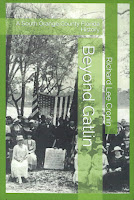Part III: Fort Gatlin’s Militia
Countdown to Pine Castle's Pioneer Days
Snell's Home, Sarasota Bay, and the Captains of 1856 Fort Gatlin
On the 7th of January 1856, Florida’s Adjutant
General notified communities throughout the state that they should form a
militia immediately to protect themselves. Indians had again gone on the
offensive, so at Fort Gatlin, veteran Indian fighter Aaron Jernigan answered
the Governor’s call by organizing an Orange County Militia consisting of
eighty-three (83) settlers. During the months leading up to the Governor’s statewide
militia call, beginning in late December 1855, the Indians had attacked an Army
regiment in southwest Florida led by Lt. George L. Hartsuff.
It had been thirteen years since the Second Seminole
Indian War had been declared over, but in 1856, fears were that a third war would
soon be underway. As in prior conflicts, the warriors did not confine their
raids on the military. “We have reliable information direct from Tampa” reported
the Alligator Advertiser of Manatee County on 16 March 1856 ”that twelve
Indians had attacked the premises of the Honorable H. V. Snell at Sarasota
(Bay), about sixty miles south of Tampa, and nine miles from the Manatee
settlement.” The homesteader, Hamlin Valentine Snell (1810-1886), was not home
at the time of the attack, but a gentleman by the name of Cunningham died in
the attack. Snell’s home was burned to the ground.
MARCH
IS SARASOTA MONTH
North of Tampa in Hernando County (now Pasco County), on 14 May 1856, yet another Indian raid claimed the life of two young children who had been standing on the porch of their family dwelling when the Indians began firing on the home. “Known today as the Bradley Massacre, a history marker now tells of the attack: “A Seminole War party attacked the home of Robert Duke Bradley of the Florida foot volunteers. Two of the Bradley children were killed before the Indians withdrew. This was the last such attack on a settler’s homestead east of the Mississippi.”
Pine
Castle Pioneer Days
February
25 & 26, 2023
Cypress
Grove Park, 290 Holden Avenue, Orlando, FL
There was, of course, no way of knowing in May of 1856 that the Bradley Massacre was to be the last such attack on homesteaders, so at Orange County, Jernigan’s militia readied itself to defend their communities. Although qualified to lead based on his years of fighting Indians in Georgia and Florida, Aaron Jernigan, in 1856, was not the right candidate for the job. He had witnessed an Indian raid in 1839 on his Georgia home, during which a member of his family was killed. Then, a decade later, Jernigan sheltered his family at Fort Gatlin (Part II) fearing yet another raid, this time on his new home in Florida.
So, in September 1856, Jernigan’s Orange County Militia needed a change of guard. The conduct of the Militia had been called in question, with some reporting that "Jernigan's company, stationed for the protection of settlements, in some cases were dreaded by the settlers more than the Indians." Charged with mistreating Indians, Captain Jernigan was relieved of command, with Isaac
Newton Rutland being named the new Captain of the Orange County militia. (Rutland, in January 1861, cast the second vote opposing Secession for Orange County. The Rutland Mule Matter, by Richard Lee Cronin).
The complete list
of Orange County’s 1856 Militia “mustered in” at Fort Gatlin will be found in
Appendix A, (page 225), of Beyond Gatlin: A History of South Orange County,
now available in Paperback or Hard Cover, by Richard Lee Cronin.
Beyond Gatlin will
be available at Pioneer Days
As most all of Florida had been surveyed during the
1840s, these surveys at times included any in place residence or fortress at
the time the survey was made. Both Fort Gatlin and the home of Hamlin V. Snell
are shown on the earliest surveys of each specific location.
Hamlin Snell’s home was built on the beach of Sarasota
Bay about two miles north of present-day downtown Sarasota. The site of Snell’s
home later became known as Indian Beach (not to be confused with Indian Rocks
Beach of Pinellas County). Today par of Sarasota, a town of Indian Beach
existed here as early as 1891. This stretch of Sarasota Bay beach, in the
1880s, had even more in common with Orange County than the Indian raid of 1856.
March: Sarasota Month - Our Shared Heritage
Pioneer Days - Day 1: Professor Paul W. Wehr Day
1856 was a pivotal year for Fort Gatlin. A
metropolitan area known up until then as Fort Gatlin became known in 1856-57 as
Orlando. The name change came about by the Militia members of 1856 who also voted
on a location for a new Orange County seat of government. For more than a
century a factual tally of that election was never accurately reported by the historians
who have written of the founding of Orlando, Florida.
The accurate result of the election of 1856 is publicly available today because of one man, a true historian, Paul W. Wehr. A professor of history at the University of Florida for twenty-five years before his retirement, Professor Wehr traveled to Tallahassee in years past and dug for the long-buried election results of 1856. And finding the tally sheets, Wehr documented the surprising results in his book, From Mosquito to Orange County, published by the Pine Castle Historical Society in cooperation with the Pine Castle Woman's Club.
I Invite you to join me at 10:15 AM, Saturday, February 25, 2023, at the HISTORY TENT at Pine Castle Pioneer Days, as I open this year's lecture series with a tribute to Author and Historian, Professor Paul W. Wehr.
Then, stop by Cronin Books Booth, adjacent to the History Tent, and say hello.




No comments:
Post a Comment